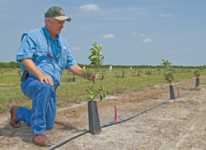Eternal Optimist

In a different era, Jerry Newlin preferred to play a low-key role and stay out of the limelight of Florida’s citrus industry. That’s partly because he is a humble man and partly because Orange-Co, where he is vice president of citrus operations, liked to go about its business quietly too, producing citrus on its 16,000 acres of groves. But, in 2006, the first confirmation of citrus greening in the company’s grove forced change — it was no longer business as usual.
“Greening came along and got our attention,” says Newlin. “From the very first confirmation, we have been committed to aggressively fighting greening in our groves. In addition, we committed ourselves as a company to be very active on the state level to push the industry to ramp up efforts to find solutions to greening, or at least, how to live with the disease.”
Newlin, along with other Orange-Co management, joined a number of committees in the state. Newlin was on the Florida Citrus Production Research Advisory Council (FCPRAC) board at the time and helped create the Greening Research Task Force and ultimately the Research and Development Foundation. One of Orange-Co’s senior managers joined the board of Florida Citrus Mutual and another joined the board of the Florida Fruit & Vegetable Association. It was all hands on “boards” in reaction to greening.
“I think my role in that place and time just put me in position to be a voice on the need to accelerate our greening research campaign,” says Newlin. “But, I can’t stress enough that this is a team effort from people all over the state. At Orange-Co, everybody who works there has been involved in this fight against greening in one way or another, so I truly view this as much a company award as an individual award.”
Aggressive Fight
Orange-Co has employed the full program for greening on its operation, scouting four times per year with aggressive psyllid control and infected tree removal. To date, they have replanted 300,000 new trees. The infection rate in the groves is running about 2% cumulatively and less than 1% on an annual basis. “We were very fortunate where we were in the state and had not been inundated by greening by the time we found it,” says Newlin. “Based on the Brazilian model, we felt that where Orange-Co is located it is isolated enough we could combat the disease the traditional way.”
Orange-Co also is monitoring and starting a nutritional therapy approach, which was recently recognized by UF/IFAS as an alternative approach if greening infection rates were so high that tree removal was not feasible.
“I really credit UF/IFAS for working with growers to study the nutritional approach with scientific rigor, because they saw tree removal was not happening in the real world in many cases,” says Newlin. “Growers with groves that have these high infection rates are in an impossible position. It is unreasonable to expect these people to push their entire groves and go out of business. So IFAS has presented the best science on what we know about nutritional therapy to help guide people in this position. Who knows where we end up, but I believe we can find a way to live with greening.”
United Front
Newlin is the first among many to admit that Florida got off to a dreadfully slow start in reaction to citrus greening and its vector, the Asian citrus psyllid. However, the industry has begun to coalesce and has created a research infrastructure built for speed. He says three things needed to happen to bring the industry where it is today.
First, we dramatically accelerated the management and amount of money being spent on greening research and took more control of how those dollars are invested. We have done this excellently with the new Florida Citrus Research and Development Foundation.”
The second major feedback from growers was the need for serious, independent peer review of proposed research projects. “If we are going to spend this kind of money, we want serious peer review,” says Newlin. “We have done that with National Academy of Sciences review and report and other scientific review boards that we’ve established.”
The third demand was learning more about and protecting intellectual property rights of any breakthroughs developed. The growers will have a license to develop the product themselves and potentially profit for the technology if it is sold elsewhere.
Newlin says accomplishing those three things was not easy, more like turning a large ship, but after three years the ship is pointed in the right direction. There is a lot of money on the table and many research projects are ramped up and running in a mad dash for answers. “We have professional expertise in all these areas and are beginning to see some extremely positive results,” says Newlin. “They say we’ve spent $18 million per year for the past two years, but it is not like this money has been sitting in the researchers’ hands for two years. Now that we have the research and development infrastructure in place, we are very excited about the positive results we’ve already seen as the funding is beginning to have a real impact.”
One of the strongest recommendations from the National Academy of Sciences was the industry must work together in an unprecedented way if it hopes to survive greening. One of the most immediate ways that can happen is through area-wide management of psyllids.
“One thing we get some credit for was back in the fall of 2007, Orange-Co helped organize an area-wide spray for psyllids,” says Newlin. “We call our group the Northeast Desoto County Growers Group and have had several coordinated sprays since then. Our approach has been used as a model across the state of how neighbors can work together to achieve maximum results in psyllid control.”
According to Newlin, the next big thing in the fight against greening is the movement toward Citrus Health Management Areas (CHMA). “The idea is to coordinate groups of growers on a map to work at certain goals like psyllid control. This would be a voluntary effort, but could really benefit specific areas.
Newlin is the chairman of the CHMA subcommittee of the Florida Research and Development Foundation. He will help formulate a plan to create the zones on the map and recruit growers from the different areas to drive local buy-in of the CHMA approach.
Warm Words
Though he is probably more comfortable away from the center of attention, there are many in the state’s citrus industry who appreciate Newlin’s hard work and hours he’s put into the fight against greening. The two previous Citrus Achievement Award winners are among them (see Peter McClure’s Last Word).
“Jerry Newlin is at the top of my list,” says Jim Snively, the 2008 Citrus Achievement Award winner. “He has been one of the strong leaders that has played a major role in getting the research efforts to where they are today.”
“This is a well deserved award for Jerry,” says Mike Sparks, executive VP/CEO of Florida Citrus Mutual. “Not only is he a terrific citrus grower, but he has worked tirelessly on the industry’s research effort — first as part of FCPRAC and now on the Florida Research and Development Foundation. I’ve sat through countless meetings with Jerry and he always brings a well thought-out perspective to the table. It is this type of thinking and analysis that will ultimately help our industry defeat the immense challenges we now face. Florida Citrus Mutual offers our sincere congratulations to Jerry.”
Newlin will quickly return the warm words with compliments of his own to the various stakeholders in the industry. After all, isn’t that what it is all about? An unprecedented coordinated, unified front to ensure that Florida’s signature fruit thrives for generations to come.
“The good news is we are much further along now on this research push,” says Newlin. “The bad news is we still don’t have an answer, but I am an eternal optimist. We are going to give everything that we’ve got, so years from now when we look back at our time in this industry, we’ll know we gave it all we had.”











